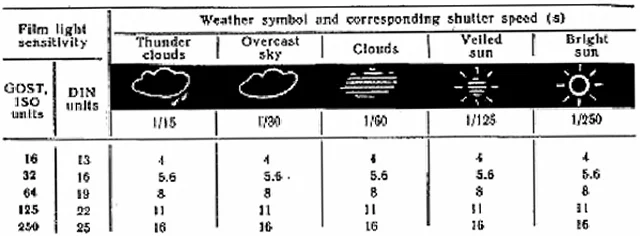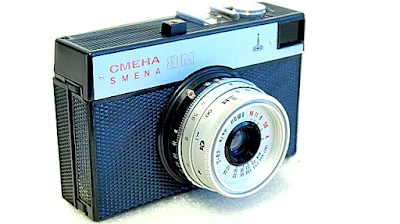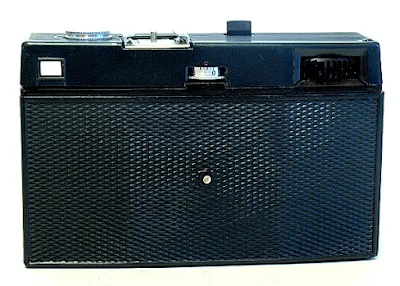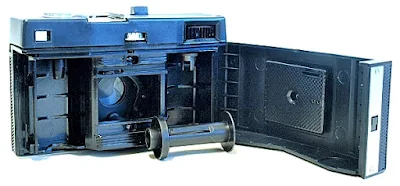It looks like I am jumping straight into the deep end of the pool with this really exciting old-school everything manual Smena 8M 35mm viewfinder camera. Produced by the LOMO factory of the Soviet Union, the Smena 8M was in production from 1970-1985, making it to the Guinness Book of Records as the most popular camera in the world, with a record sale of over 21 million copies. How's that for a fact?
Though built on the cheap with plastic and brushed aluminum components and is often referred to as a toy camera, the Smena 8M has a surprisingly well-regarded scale focus multicoated fixed glass lens, the LOMO factory designated T-43 40mm F4.
The lens, which is awesome for a cheap viewfinder camera, should augur well against ghosting, flare, or loss of contrast as you would otherwise get.
In use, everything on the camera is manual, from loading and unloading the film, advancing the film frame, doing the mental math on the Sunny 16 rule for aperture and shutter speed setting, actuating the leaf shutter, and releasing the shutter itself. The Smena 8M does not need a battery to operate, it does not have a self-timer, nor a dial for film ISO speed setting.
LOMO Smena 8M | King of multiple exposure
Lomo Smena 8M - The handsome Vintage Soviet Era point and shoot Camera and king of multiple exposure. Best Features: Glass lens and leaf shutter.
All set to go? Straightforward and simple as it is, having fun with the Smena 8M means that there is still a small learning curve you have to come to terms with./p>
Basic Camera Features
The Smena 8M, though technically a very competent camera, is simplicity itself. The boxy plastic body is adorned with a brushed aluminum top front plate displaying the branding exercise, which may be slightly different depending on the model number and iteration of its build cycle. A version of the camera with a black nameplate and an ultra-rare all-black version is also available.The lens mount housing is central to the front of the camera, placed just below the brushed aluminum nameplate decal. Surrounding the front lens element is a ribbed aperture ring that can be rotated to adjust the 8-bladed aperture to the value shown in red on the lens front. This lens and aperture control mechanism is housed within the focusing ring, which is the whole front of the lens.
Focusing is done by rotating the ring to line up the metric distance scale or graphic icon against an arrow pointer located on the apex of the focusing ring housing. The aperture numbers down the sides of the focus ring indicate the depth of the field scale. The numerals are equally adept when the camera is used for hyperfocus shooting.
Next is a thin metal ribbed-edge shutter speed ring which will adjust the leaf-spring shutter for Sunny 16 lighting ambiance, or for shutter speed from B, 1/15 to 1/250 second. Adjusting the weather conditions from Full Sun, Partial Sun, Partial Cloud, Full Cloud, and Rain Cloud will correspondingly change the shutter speed setting from 1/250 second down to 1/30 second. Nudge the pointer beyond the Rain Cloud setting, and the shutter speed will go into Bulb mode.
The shutter is actuated by pressing the leaf shutter lever down until it clicks into place, and you are now ready for the shot.
The top plate of the camera is equally simple and uncluttered. There is the shutter release button fitted with a screw-in cable release socket, a cold shoe, and the circular silver film rewind knob. The rewind the film you need to pull the knob slightly out from the body and press the shutter button before you start rewinding, which might take you ages to finish.
On the back of the top plate, from left to right, are the viewfinder window, film counter, and film forward crank. The film back is plain.
A tripod socket is located on the bottom plate of the Smena 8M.
The film box is tight and tidy, and should not be a problem if you are familiar with loading film cameras.
Viewfinder Readout
The viewfinder readout of the Smena 8M is nothing more than a plain glass 1:1 tunnel view of the image you are framing. The viewfinder, being located on the top left-hand corner of the body, is practically useless when viewing images at close distances. In such a situation, the best is to just frame and shoot by guesswork.Loading and Unloading Film
The film counter of the Smena 8M is still a mystery to me as to how it works. What I normally do is rotate the counter until it sets itself to 0 (zero) before loading the film, winding, and shooting normally until the film roll reaches its end. The loose take-up spool that should come with the camera is something you will want to make sure is always there and is not missing from the package.The Lomo Smena 8M - Loading 35mm Film
The Lomo Smena 8M's (http://bit.ly/2EKNAFi) secret weapon? Its excellent high-contrast glass lens that yields exceptionally sharp images and deep colors. ♥ FOLLOW US ♥ Instagram: https://www.instagram.com/lomography/ Facebook: https://www.facebook.com/Lomography/ Twitter: https://twitter.com/lomography Pinterest: https://www.pinterest.at/lomography/ Tumblr: https://lomographicsociety.tumblr.com/ https://www.lomography.com
Rewind the exposed film back into its original spool before you unload it from the camera. To do this, pull up the silver rewind platter slightly up from the top plate, and use your left thumb to press the shutter release and your right hand to wind the platter clockwise all the way until the exposed film is completely back in its canister.
Using the Camera
As mentioned, using the camera is fun and easy. The key is the basic understanding of the Sunny 16 rule and the film ISO speed, which you will set as soon as the camera is loaded with the film roll of your choice.The chart below, an extract from the manual, shows the aperture setting recommendation.

The corresponding values for the classic GOST system are as follows:
- F4 - GOST 16 - ASA 25
- F5.6 - GOST 32 - ASA 50
- F8 - GOST 64 - ASA 100
- F11 - GOST 125 - ASA 200
- F16 - GOST 250 - ASA 400
Next, set the camera's shutter speed according to the lighting conditions, and use the weather icons to guide you. For reasonably well-lighted interiors, you can use the rain cloud speed of 1/15 second. Use the focal ring next to set up the subject distance. Do this by estimating the distance or by using the engraved distance icons.
Cock the shutter, frame the image, and shoot away!
A more adventurous option is to work around the camera's aperture setting for more creative effects. You can, for example, use a large aperture (F4) for a close-up image shot against a blurry background. Just remind yourself that for each step that you enlarge the aperture (say, from F5.6 to F4), you should also increase the shutter speed (from 1/30 to 1/60) to compensate for the increased light, and vice versa.





















No comments:
Post a Comment